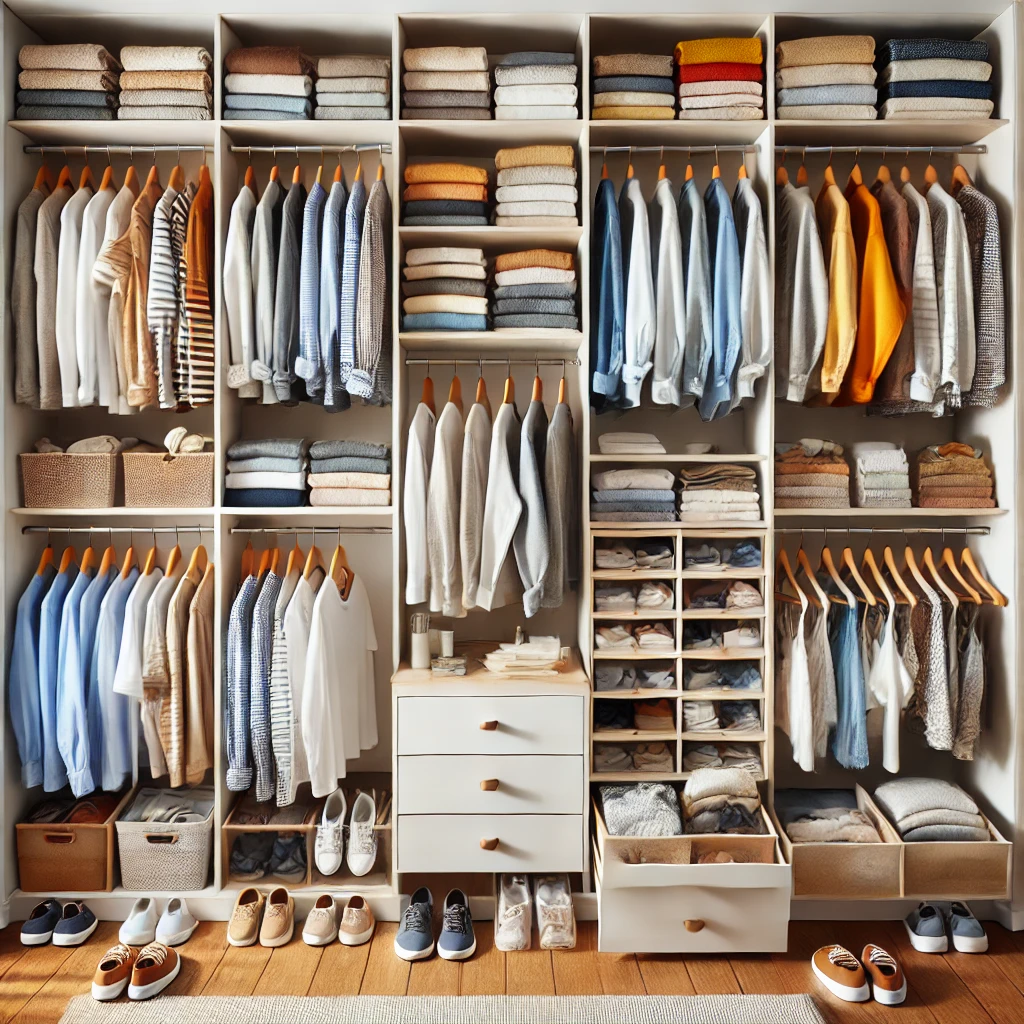A well-organised wardrobe makes everyday life easier. It saves time when choosing outfits, prevents clutter, and helps you make the most of the clothes you already own. Instead of struggling with messy shelves and misplaced items, you can create a system that keeps everything tidy and accessible. With a few simple steps, your wardrobe can become a space that works for you, not against you.
Step 1: Declutter and Sort Your Clothes
The first step in organising your wardrobe is decluttering. Take everything out—yes, everything. While this may seem overwhelming, it’s the best way to see what you actually own and what truly deserves a place in your space.
As you go through each piece, ask yourself:
- Do I wear this regularly? If yes, keep it.
- Does it fit well and make me feel good? If not, it may be time to let it go.
- Is it in good condition? If it’s too worn out, consider repurposing it.
- Have I worn it in the past year? If not, chances are you won’t wear it again.
Be honest with yourself. Holding onto clothes just in case leads to a cluttered wardrobe filled with unused pieces. Letting go of what you no longer wear creates space for the items that truly matter.
Once you’ve sorted your clothes, separate them into categories: what to keep, donate, or repurpose. By the end of this step, your wardrobe will already feel lighter and more functional.
Step 2: Organise Clothes by Type and Frequency of Use
Now that you’ve decluttered, the next step is arranging your clothes in a way that makes getting dressed effortless. The goal is to make everything visible, accessible, and easy to maintain.
Start by dividing your wardrobe into sections based on clothing type and frequency of use. Everyday essentials, such as workwear, casual outfits, and gym clothes, should be placed in easy-to-reach spots. Seasonal or special occasion items can be stored higher up or in less accessible areas.
Hanging clothes is ideal for items that wrinkle easily or need to maintain their shape. These include:
- Shirts
- Dresses
- Blazers
- Skirts
- Coats
To make things even more practical, organise these items first by category and then by colour. This way, you can quickly find what you need without having to sort through everything.
For clothes that don’t wrinkle easily, such as t-shirts, pyjamas, and activewear, folding is the best approach. These items take up less space and stay neat when stored in drawers or shelves.
One of the best space-saving techniques is the rolling method, where clothes are rolled instead of stacked. This keeps everything visible and prevents messy piles. It’s especially useful for soft fabrics, towels, and swimwear.
Jeans and coats require different storage methods. Jeans can be either hung or folded, depending on your space. Since denim doesn’t crease easily, both options work well. Coats should be hung on sturdy hangers to support their weight and maintain their shape. Occasion wear or delicate fabrics should be stored in protective garment bags to prevent dust and damage.
For drawers and shelves, grouping items by category—such as loungewear, sportswear, and accessories—keeps everything organised. Sorting by colour makes outfit selection faster and more efficient, allowing you to spot the right shade at a glance.
Step 3: Use Storage Organisers to Maximise Space
The right organisers can transform your wardrobe by creating structure and preventing clutter. They help keep everything in place so you don’t have to rummage through piles of clothes every time you need something.
Drawer organisers are ideal for smaller items like underwear, socks, and bras. They keep everything separated and easy to access. No more searching for matching socks in a messy drawer.
For accessories, use small boxes, hanging organisers, or hooks to store scarves, belts, and gym gear neatly. This prevents them from getting tangled or misplaced.
If your wardrobe has high shelves, storage boxes are perfect for keeping less frequently used items in order. Seasonal clothing, such as winter coats and summer dresses, can be packed away when not in use to free up space.
Many people assume that organisers take up extra room, but they actually do the opposite. They optimise the space you already have, making it easier to maintain an orderly wardrobe.
The Benefits of an Organised Wardrobe
A well-organised wardrobe isn’t just about aesthetics. It simplifies your daily routine, reduces stress, and helps you get the most out of your clothes.
- Saves time – No more searching for misplaced items. Everything is exactly where it should be.
- Reduces clutter – Keeping only what you need prevents overcrowding.
- Prevents unnecessary shopping – When you can see all your clothes, you’re less likely to buy things you don’t need.
- Creates more space – Proper folding, hanging, and storage techniques make the most of your wardrobe.
Now that you know how to organise your wardrobe effectively, take some time to put these strategies into action. A well-structured wardrobe will not only make your mornings smoother but also help you feel more in control of your space.

